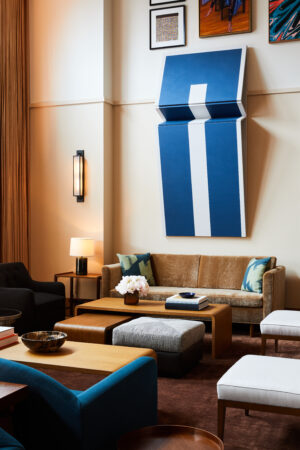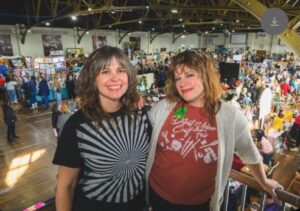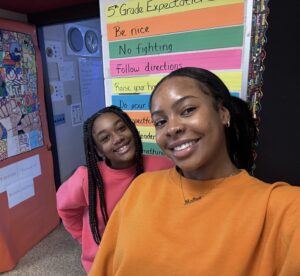Sara Nickleson: We were first given a design brief and were energized by Gachot’s plans—every detail was well-considered in regards to materials, textures, form and purpose of the spaces. We knew that the hotel was going to add a transformative element to Shinola’s brand and their significance within Detroit and beyond. Library Street Collective is located within steps of the hotel, so it was crucial for us to meet that same standard, and bring something new to the table. It was important to us to show an eclectic variety of works that each spoke to the brand in their own way and worked as a collection of local and international artists—museum quality pieces among photographs, ephemera, timeless oil painting, and pieces that reflected relationships between Shinola, Library Street Collective and the artists.
CVh: Did the hotel have a clear vision of what they were trying to evoke?
SN: They had a very clear vision of the style of hanging they hoped to include—Gachot and Daniel loved the idea of salon-style walls and they were incredibly open to our direction. Normally when you see a salon-style installation, it often includes a lot of photography, prints, ornate frames on oil paintings, etc. We were exhilarated by the possibility of using that as a starting point and still breaking away from it, so we brought in big contemporary works, shaped canvases, text-based paintings and lots of color to create something really special.
CVh: What does the “living room” bring to mind for you?
I’ve spent a lot of time working in the living room since the hotel opened, and it has become such a communal place—people have meetings, work on their laptops with headphones, snack and catch up with friends, have a drink before dinner, and take tons of photos. It’s the heart of the hotel and sets the tone for the mezzanine above, the guest rooms and spaces in between. It’s an inspiring space—warm, energetic, and thoughtful.
CVh: Creating a public living room for a city is a big task. When you were choosing art for this room, did you imagine who would be seeing it, and how they would be interacting with it?
SN: Yes, definitely. Shinola is a brand that belongs to everyone and especially to Detroiters. We wanted to present local artists Charles McGee, Beverly Fishman, Scott Reeder, Tiff Massey, Greg Fadell, James Benjamin Franklin, Mario Moore, Matthew Lisk, and Margo Wolowiec alongside national and international artists who have expressed love and interest in Detroit, or have a history of living and working in the city—Nick Cave, Jason Revok. We wanted it to be a destination on people’s list of things to see in Detroit, even if they weren’t staying at the hotel. I think it’s an exciting space for people who know and love the artists on display, yet evokes an entirely different admiration from people who are unfamiliar with the names and stories included. We’ve been told that people ask regularly about the artists. We have provided information to the staff so that they can share it with visitors who want to know more.
CVh: When it came to choosing local artists to feature, how did you find them? Are they all artists you’ve worked with through Library Street Collective?
SN: We’ve worked with all of the local artists included in some capacity, whether through solo or group shows, previous acquisitions to clients, or other public and commercial projects facilitated by Library Street Collective. A few were commissioned for specific placement in the living room and other areas.
CVh: What’s something you want people to know about this collection that might not be obvious?
SN: To some it might look like a pretty random collection of works, but it took a significant amount of thinking and rethinking, countless layouts and redesigns to arrive at the collection and installation that was executed. In order to make such different styles work together harmoniously and in line with Shinola’s culture, thousands of works were poured over. It was well worth the effort and we hope that guests to the hotel love it as much as we do.
CVh: What is your favorite part of this collection?
SN: Definitely the Tondo by Nick Cave – it’s jaw-dropping in the living room space. It’s such a significant piece and similar works by the artist have been shown in museums all over the world. Cave is an exemplary graduate from Cranbrook who studied under Beverly Fishman and creates surreal and intricate works that begin with performance (his famous Soundsuits) and carry on their story into his circular wall works like Tondo. The piece is made from found fabrics sewn together by hand, and it catches the light coming through the living room windows in a way that makes it really come alive.
CVh: As someone whose profession it is to find and show new art, what’s your advice to young artists?
SN: Make as much work as you can and get to know the artists, galleries, and museums in your area. The art world is just as much about relationships as it is about what you create. Be present and supportive of others and it will come back to you.





















